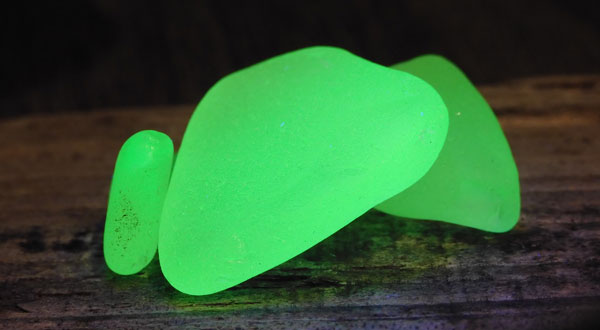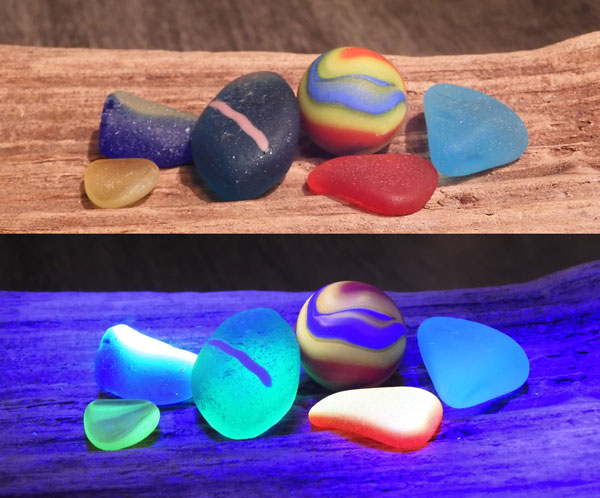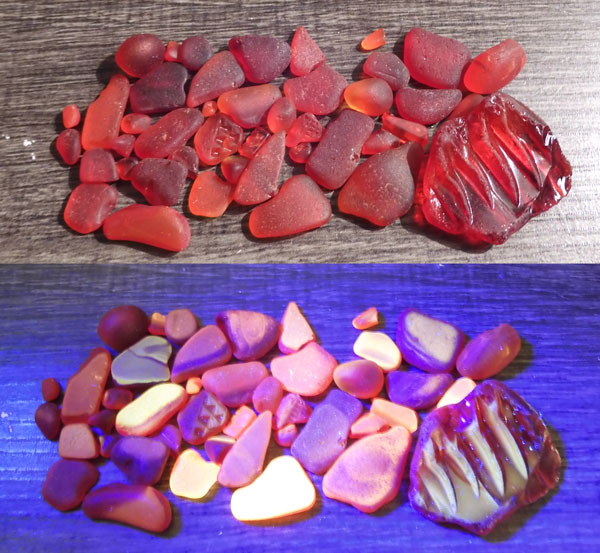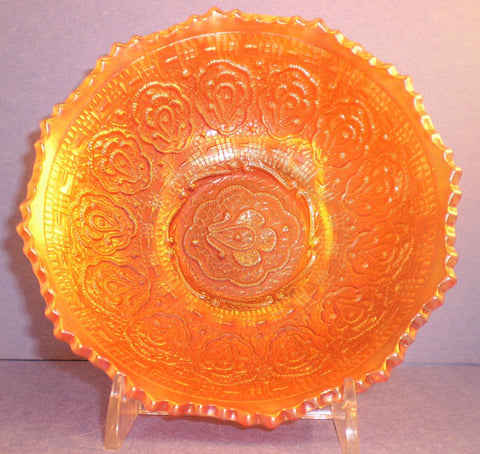Ultraviolet Sea Glass
 The Magic of Glowing Glass
The Magic of Glowing Glass
By Kirsti Scott
While every piece of beach glass is special, something magical happens when you find a piece that glows. Mixed in with all the regular pieces of sea glass we find on beaches around the world, there are sometimes pieces that were made with fluorescent materials. If you shine a black light on them, they will glow a bright green, orange, red, purple, or yellow color. These are known as fluorescent or ultraviolet glass, or simply UV glass.

Shine on
Scientifically, fluorescence is caused by substances in the glass absorbing invisible ultraviolet light and then releasing the energy as visible light and heat. Glass manufacturers included fluorescent materials in UV glass to create certain decorative colors, such as bright green Vaseline glass, or make glass that was highly visible, such as the bright red glass used in tail lights. They did not necessarily know or care that the materials would glow under black light.
Even without black light, UV glass sometimes has a subtle glow even when there’s only a little bit of sunlight. If you look at a piece of UV glass sitting in the sun as dusk falls, you might even catch a faint glow. The glow is similar to that of a highlighter pen, which looks brighter than a plain yellow pen when even just a little bit of UV light hits it. Shine a black light on your paper that’s been highlighted, and you’ll see the same brilliant effect as shining a light on UV glass.
There are several types of UV glass that were mass produced and most likely are the source of the UV sea glass that you might find. The colors of the glass and the UV glow depend on the chemicals used to create the glass.

Uranium
Uranium is the most common ingredient in UV glass. There are several types of glass that were made with uranium in them. Yes, the same uranium used for bombs and nuclear power reactors. Fortunately, the amounts used to make uranium glass are tiny.

Vaseline glass, or Canary Glass, is a yellow-green glass mainly produced for tableware and household items from around 1840 up until World War II. It gets its yellow or greenish-yellow color from uranium dioxide (UO2), which was used as a colorant. Vaseline glass came as glasses, plates, lamps, doorknobs, bottles, decorative items, decanters, and more. The uranium in Vaseline glass gives it the glass its bright-green color in natural light, and causes the glass to glow vivid neon green under a black light.

Other types of uranium glass, which also glow under UV light, include opalescent green uranium glass, teal carnival glass, milk glass, opaque custard and Burmese glass, opaque or semi-opaque jadeite glass, and transparent or semi-transparent pale-green Depression glass. Uranium glass was also used in marbles to create swirls of bright colors, so your sea marbles may glow under a black light, too.
During WWII, the U.S. confiscated all uranium, and prohibited the use of uranium for glass production. After the war, production resumed, though a lower-grade, less-fluorescent version of uranium was used and only limited quantities are produced today, mostly for novelty or decorative pieces. No more place settings of uranium glass are produced these days.
A property of uranium—totally unrelated to its fluorescence—is its radioactivity. The radioactivity of uranium glass is actually measurable with a Geiger counter. However, since only small amounts of uranium, often less than 1%, were used during the manufacture of the glass, the amount of radioactivity in uranium glass is not considered harmful. And, the radioactivity doesn’t leak out quickly into liquids stored in a uranium glass container, so it’s safe to use.
Maybe if you ground the glass into powder and swallowed the results it might be unhealthy, but the most dangerous part of dealing with uranium glass is actually using the black light, which emits ultraviolet rays. (Safety note: Never look directly into a UV flashlight, don’t shine it into anyone else’s eyes, and if you’re particularly worried about UV exposure, wear UV protective glasses.)
Manganese
Manganese (Mn) is one of the oldest glass additives and was used to colorize glass as far back as Ancient Egypt. Manganese produces glass in a range of colors from violet and green to yellow and orange. Reddish orange manganese glass is sometimes called “persimmon glass.” Manganese Dioxide (MnO2) was also used to decolorize glass containing iron impurities, or to stabilize the color of glass so it wouldn’t shift over time. Glass that contains manganese glows green, red, orange, or peach under black light.
Selenium and Cadmium

Selenium (Se) is used in high concentrations to make yellow, orange, and red glass. Cadmium combined with Sulphur (CdS) is used to create yellow and orange glass. When Selenium is combined with Cadmium Sulfide, it creates a brilliant red glass known as "Selenium Ruby." Chemist Nicholas Kopp discovered the use of selenium to make red glass in the 1890s and his glass works, Koop Glass, is famous for manufacturing railroad and traffic signal lights in well known “stop-light” red.

Beginning in the 1920s, selenium and cadmium were used to make press-molded Carnival Glass (including “amberina” glass), household tablewares, and automobile taillights. Selenium glows a pale pink or orange under UV light. Cadmium glass glows yellow, pink, orange, or red under UV light.
UV Pottery
“Sea glass isn’t the only thing on the beach that can fluoresce under blacklight,” said Mary McCarthy, Education Director & Board Member, North American Sea Glass Association. “You should also check your sea pottery collection. Certain glazes were also made with traces of uranium, and some historical patterns will glow under ultraviolet light as well, though this is a rare find for the beachcomber to treasure.”
Identifying UV glass
When you pick up a piece of sea glass on the beach, it’s not always immediately obvious that it's UV glass. You can’t really verify that it’s UV glass without the use of a black light (or a Geiger counter), so the best way is to check everything you find to see if it glows.
Darken the room, shine your UV flashlight on your finds, and note what color glow your fluorescent pieces give off. After that, you can use the shape, texture, and color of the piece to try to figure out where the piece came from, and what ingredient in the glass is responsible for its glow. For example, a curved, white piece that glows bright green may be a cup handle from some uranium glass. And, a yellow piece that glows orange is probably made with manganese, cadmium, or selenium.
You can purchase UV flashlights online. Just search for “UV flashlight” or “blacklight flashlight” and you can find them in all sizes from pocket size to industrial size. For a surefire way to find UV sea glass, Mary McCarthy suggests bringing your UV light to the beach at night.
I love the Convoy S2 which doesn't cast a purple glow and is strong enough to show fluorescences in a range of colors, including lavender sea glass. Maybe consider the uvBeast, “the Godzilla of all UV flashlights,” which says it floods a 30-foot area, which might help you spot a piece of glowing glass from across the beach.
In any case, take a few minutes to check out your sea glass, sea pottery, and sea marbles for any glowing UV pieces that you may have picked up unknowingly. You may just find a bit of beach glass magic in your collection!
For more color-changing glass magic, read about neodymium sea glass ›
This article appeared in the Glassing Magazine January/February 2018 issue.
Watch videos about all the colors of sea and beach glass
Learn more about sea and beach glass colors:
5 comments
I bought a black light to look for yooper lite rocks and found a ton of my pottery and beach glass I had glows. I am stoked!
Wow I never knew you could get glowing sea glass I have got loads of sea glass I gotta check this out!!!!!!!!!!!!!!!!!!!!!!!!😉😉😉😉😉😉😉😊😊😊😊😊😊😊😊
You guys are gonna have so much fun with the black light flashlights! Be sure to get up really close so you can find all your glowing pieces!
I just purchased a black light and discovered that I have multiple pieces of UV glass. Had no idea that pottery could glow! Will check that next!!
Just took a uv light to my collection and found a glowing marble! I’m over the moon! I just wish I knew more about it!








